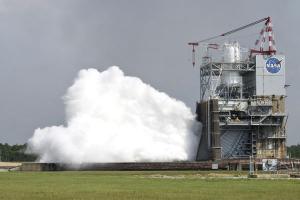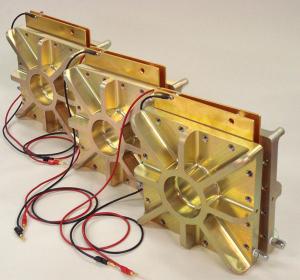Partnership demonstrates fuel cells for helium recovery at NASA
University of Hawaiʻi at MānoaJunior Researcher, Project Manager, Hawaii Natural Energy Institute
Richard Rocheleau, (808) 956-8346
Director, Hawaii Natural Energy Institute
The University of Hawai‘i at Mānoa's Hawaiʻi Natural Energy Institute (HNEI), together with Sierra Lobo Inc., has demonstrated the recovery of high-purity helium from hydrogen/helium mixtures produced at rocket engine testing sites using proton-exchange-membrane fuel cells.
The National Aeronautics and Space Administration (NASA) uses a large amount of helium gas — about a million cubic feet per launch to purge hydrogen from their fuel lines. Helium gas, contaminated with hydrogen, is expensive and energy-intensive to purify and recover. Capitalizing on expertise at HNEI, Sierra Lobo technologists challenged the team to use proven fuel cell technology to develop an efficient recycling process for helium.
"HNEI optimized proton-exchange-membrane fuel cell (PEMFC) technology to electrochemically separate the two gases,” explained Richard Rocheleau, HNEI’s Director. Separation was achieved by applying electrical energy to the fuel cell, rather than using it to produce energy.
“Fuel cell technology is an excellent choice for separating the helium from hydrogen-helium mixtures,” said Mike Angelo, project manager from HNEI. “The fuel cell uses a catalytic reaction and membrane transport to remove the hydrogen, allowing for the efficient recovery of very high purity helium.”
In laboratory experiments, HNEI demonstrated that contaminated gas streams with up to 50% hydrogen can be refined to produce 99.995% pure helium. A pilot-scale Helium Reclamation System was designed and built by Sierra Lobo and its performance was validated on-site at the NASA Stennis Space Center in Mississippi.
“Sierra Lobo combines advanced engineering services with developing, manufacturing, and marketing new and enhanced products and processes for the aerospace, transportation, and energy industries,” said Sierra Lobo President and CEO George Satornino. “This project gave us the perfect opportunity to leverage our engineering know-how with HNEI’s fuel cell expertise to develop a unique prototype turnkey system, tailored to NASA’s needs.”
HNEI developed a chemical reactor model to estimate the PEMFC size needed to attain a specific helium purity for different hydrogen concentrations and processing rates. The model was used by Sierra Lobo to size fuel cell technology used in the pilot-scale separation system.
Development and initial testing was conducted at HNEIs’ Hawai‘i Sustainable Energy Research Facility (Hi-SERF), formerly known as the Hawai‘i Fuel Cell Test Facility, a state-of-the-art laboratory specializing in PEMFCs and battery testing. Located within a secured area on Hawaiian Electric Company (HECO) property in downtown Honolulu, this 4,000-square-foot facility currently houses an extensive array of cutting-edge equipment to test fuel cell materials, fuel cells and cell stacks, and compact fuel cell systems (up to 5 kW). More recently, HiSERF has expanded its focus to include battery energy storage systems in support of HNEI’s grid-scale storage projects conducted in collaboration with HECO.
Although helium is relatively rare, its commercial applications are extensive. Helium’s uses vary widely — from cryogenics, to superconducting magnets, to growing crystals for semiconductors, to hospital MRI use. Starting with NASA’s interest in helium recovery, this project has promising implications worldwide.
This work was made possible by funding from Sierra Lobo under their Small Business Technology Transfer award from NASA.
Contact information for researchers/partners:
Mike Angelo, HNEI Project Manager, (808) 593-1714, mangelo@hawaii.edu
Bradley Stoops, Sierra Lobo, Inc., (419) 499-9653 ext. 119, bstoops@sierralobo.com
About Sierra Lobo, Inc.
Founded in 1993, Sierra Lobo, Inc. is a Hispanic-American-owned small disadvantaged business with a staff of 520 dedicated professionals based in Fremont, Ohio. Sierra Lobo is a two-time winner of NASA’s most prestigious quality award, George M. Low Award, most recently in 2011. Sierra Lobo is also a winner of two R&D 100 Awards for development of advanced technologies. The company is certified to the International Aerospace Quality Group AS9100 standards, registered under the International Organization for Standardization (ISO) 9001:2008 as a provider of technical and engineering services for aerospace and transportation industries, and rated as Capability Maturity Model Integrated (CMMI®-DEV) Capability Level 2 fully compliant and Level 3 compliant in Risk Management.
About Hawaiʻi Natural Energy Institute
HNEI is an organized research unit of the School of Ocean and Earth Science and Technology at the University of Hawai‘i at Mānoa. The Institute performs research, conducts testing and evaluation, and manages public-private partnerships across a broad range of renewable and enabling technologies to reduce the State of Hawaiʻi's dependence on fossil fuel. Fuel cell testing is performed at the Hawai‘i Sustainable Energy Research Facility, an HNEI laboratory funded by the Office of Naval Research, with operations supported by the Hawaiian Electric Company.
About SOEST
The School of Ocean and Earth Science and Technology at the University of Hawai‘i at Mānoa was established by the Board of Regents of the University of Hawai‘i in 1988 in recognition of the need to realign and further strengthen the excellent education and research resources available within the University. SOEST brings together four academic departments, three research institutes, several federal cooperative programs, and support facilities of the highest quality in the nation to meet challenges in the ocean, earth and planetary sciences and technologies.
For more information, visit: http://www.hnei.hawaii.edu/projects/helium-recovery-rocket-test-systems



